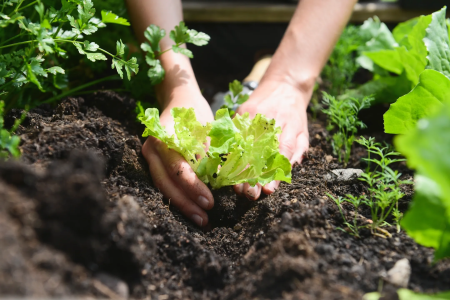No-Till Landscaping: A Comprehensive Guide to Sustainable Gardening
In an era where environmental conservation is at the forefront of our minds, no-till landscaping has emerged as a transformative solution for eco-conscious gardeners. With an estimated 35% of U.S. farms already embracing no-till agriculture practices (source), this approach is gaining traction among homeowners looking to create sustainable, low-maintenance gardens. By focusing on soil health, biodiversity, and water conservation, no-till landscaping offers a greener alternative to traditional gardening methods—all while requiring less long-term effort.
Ready to transform your garden? Let’s dive deep into the world of no-till landscaping, its benefits, and step-by-step guidance to implement this eco-friendly technique.

What is No-Till Landscaping?
No-till landscaping, also known as no-dig gardening, eliminates the need for turning or tilling soil—a common practice in traditional gardening. Instead, it focuses on layering organic materials on top of the soil to create a fertile and low-maintenance growing environment.
By avoiding soil disturbance, no-till landscaping:
- Maintains the natural structure and composition of soil.
- Protects beneficial microorganisms and insects.
- Suppresses weed growth by smothering seeds with mulch.
In essence, no-till gardening mimics the natural ecosystem of a forest floor, creating a thriving environment for plants and wildlife.
The Benefits of No-Till Landscaping
Switching to no-till gardening offers a range of benefits for both your garden and the environment:
1. Improved Soil Health
- Preserved Structure: Tilling disrupts the soil’s natural structure, depleting nutrients and disturbing microbial life. No-till methods keep the soil intact, promoting fertility and better water retention.
- Microbial Activity: Healthy soil teems with microorganisms that break down organic matter and enrich nutrients. By leaving the soil undisturbed, no-till gardens foster this natural process.
2. Erosion Control
- Tilling often leaves soil vulnerable to erosion from wind and rain. No-till landscaping prevents this by preserving the topsoil layer and covering it with protective mulch.
- The mulch layer acts as a barrier, reducing runoff and keeping your garden soil intact during storms.
3. Water Conservation
- Mulch retains moisture in the soil, reducing the need for frequent watering—a critical benefit in drought-prone regions.
- No-till gardens use water more efficiently, supporting plant health without wasting this vital resource.
4. Biodiversity Support
- Habitat Preservation: Undisturbed soil becomes a haven for earthworms, insects, and beneficial microorganisms. These creatures work together to create a balanced and resilient garden ecosystem.
- Pollinator Support: By reducing chemical use and creating habitats, no-till gardens attract bees, butterflies, and other pollinators essential for plant reproduction.
5. Weed Suppression
- A thick layer of mulch blocks sunlight, preventing weed seeds from germinating.
- While the first year may see some weeds as the soil transitions (Tenth Acre Farm), persistence pays off with significantly fewer weeds in subsequent years.
How to Implement No-Till Landscaping
Transitioning to a no-till garden requires a shift in mindset, but the process itself is straightforward. Follow these steps to set up your no-till garden:
1. Prepare the Site
- Start by removing large debris, rocks, or sticks from the planting area.
- For areas with existing weeds or grass, lay down cardboard or newspaper as a barrier to smother them. This biodegradable layer breaks down over time, enriching the soil beneath.
2. Choose the Right Mulch
- Opt for organic materials like straw, wood chips, compost, or shredded leaves.
- Avoid synthetic mulches, which don’t decompose and can harm soil health.
3. Apply a Thick Layer of Mulch
- Spread 3-6 inches of organic mulch over the soil surface.
- Ensure the mulch layer is consistent but leave a few inches of space around plant stems to prevent rot.
4. Planting in a No-Till Bed
- Use a trowel or your hands to create small holes in the mulch layer for planting flowers, vegetables, or shrubs.
- Cover the plant roots with mulch, ensuring they’re well-protected but not suffocated.
5. Maintain the Mulch
- Organic mulch will decompose over time, so add a fresh layer each season to maintain weed suppression and soil health.
- Monitor the mulch level and replenish as needed to keep your garden thriving.
Tips for Success in No-Till Landscaping
- Start Small: Transition a single garden bed to no-till before committing to your entire yard.
- Be Patient: The first year may require extra effort to manage weeds, but subsequent years will demand significantly less maintenance.
- Encourage Pollinators: Incorporate native plants into your garden design to attract beneficial insects and maintain biodiversity.
- Collaborate with Nature: Use companion planting to deter pests and promote plant health naturally.
No-Till Landscaping: A Long-Term Vision
No-till gardening isn’t just a method—it’s a mindset that prioritizes harmony with nature. Over time, no-till gardens become healthier, more resilient, and easier to maintain. By protecting soil health, conserving water, and supporting biodiversity, no-till gardening embodies the principles of sustainability and eco-friendliness.
How Pigybak Supports Sustainable Landscaping
Looking for landscapers who specialize in eco-friendly practices like no-till gardening? Pigybak’s home improvement app makes it simple to find contractors who align with your values.
- Sustainable Filters: Use Pigybak’s filters to find landscapers offering green-friendly services like organic mulching, soil health restoration, and pollinator-friendly planting.
- Local Connections: Support local professionals who understand your region’s unique environmental challenges.
- Efficient Group Deals: Team up with neighbors to bundle landscaping services for cost savings and reduced environmental impact.
Sign up for Pigybak today and bring your sustainable garden vision to life.
Conclusion: A Greener Future, One Garden at a Time
No-till landscaping is more than just a gardening trend—it’s a sustainable solution that nurtures the earth while reducing maintenance for gardeners. Whether you’re an experienced gardener or just getting started, no-till techniques can transform your outdoor space into a thriving, eco-friendly haven.
By preserving soil health, conserving water, and supporting biodiversity, no-till landscaping offers long-term benefits for both your garden and the environment. Ready to embrace this sustainable approach? Connect with Pigybak to find the perfect green-friendly landscapers to help make your vision a reality.
Let’s cultivate greener spaces and a brighter future—one no-till garden at a time.


